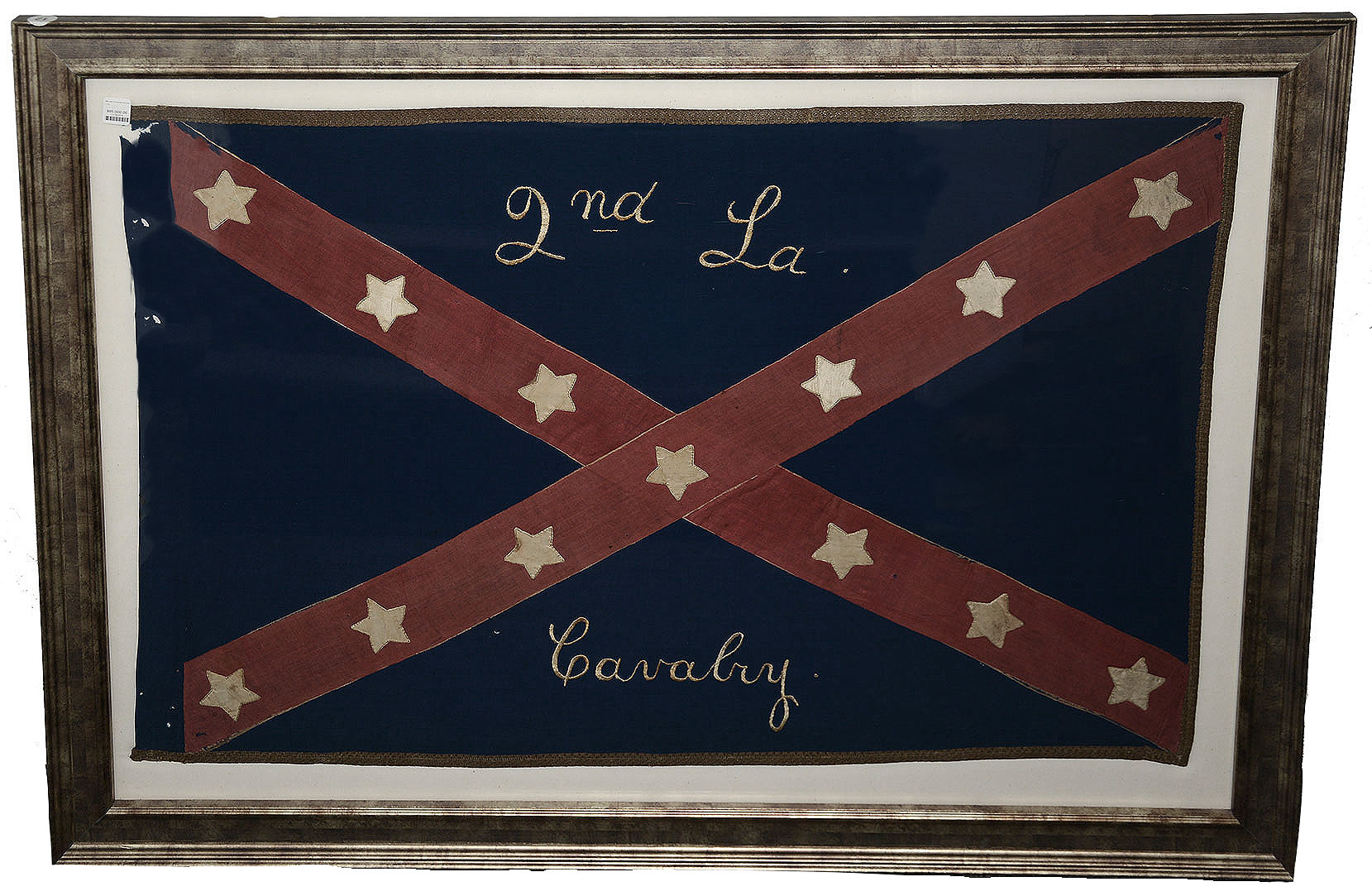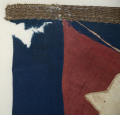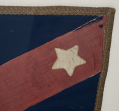site search
online catalog
TRANS-MISSISSIPPI PATTERN BATTLE FLAG OF THE 2ND LOUISIANA CAVALRY, CAPTURED AT HENDERSON HILL, LOUISIANA, MARCH 21, 1864, BY SERGT. WILLIAM AYRES, 35th IOWA INFANTRY

$85,000.00
Quantity Available: 1
Item Code: 1179-012
Shipping: Determined by Method & Location of buyer
To Order:
Call 717-334-0347,
Fax 717-334-5016, or E-mail
This great looking, great condition, completely original and well documented Confederate battle flag, carried by the 2nd Louisiana Cavalry and captured on March 21, 1864, by Sergeant William Ayres of the 35th Iowa Infantry during a night attack on the regiment and an accompanying Texas artillery battery at Henderson’s Hill, Louisiana, March 21, 1864. Loaned to a southern Oregon historical society by Ayres’s son in 1950, the flag passed into that society’s possession as a donation in 1971, was deaccessioned about 2010 as not germane to their mission of preserving local history or that of local pioneer families (Ayres’s son had only moved there about 1928,) and was acquired by the Texas Civil War Museum.
The flag has been fully conserved by Textile Preservation Associates, archivally mounted and framed in a gilt frame measuring 33-1/4” by 47” and is ready for display. It comes with an extensive file containing conservation reports, recommendations for handling and display, information on the flag’s capture and its captor, as well as documents dealing with its deaccession, and correspondence from several southern museums and a Sons of Confederate Veterans Camp seeking to acquire it between 1993 and 2010. The flag was discussed and illustrated by a line drawing in a Company of Military Historians journal article, “Unit Flags of the Trans-Mississippi Confederacy – Pt. II,” by Madaus and Needham, who note it is one of several distinctive battle flags (one of three known at the time) adopted by regiments of Lt. Gen. Richard Taylor’s District of West Louisiana of the Trans-Mississippi Department. These flags follow the general pattern of the Army of Northern Virginia battle flag as modified in the Trans-Mississippi Department, but reverse the colors of the field and the St. Andrew’s Cross, producing a red cross on a blue field. Its retention by its captor rather than being turned into the Federal government is not unusual among flags taken from units in that department, with some that were turned over even being transferred back to the states whose troops had captured them. A 2010 discussion on a message board indicated three other flags associated with the unit were known in southern museums: one from its early organization as a battalion, along with a guidon and a regimental color presented in October 1864 by ladies of DeSoto Parish, likely a replacement given to the remnants of the unit as a replacement for this one.
We summarize the TPA report, which potential buyers are welcome to read in full. The flag measures 26 1/4" by 40 1/4" and is made of two layers of blue wool challis. [We note that the CMH article mistakenly reports it to be made of silk.] The 3 1/2" wide St. Andrew’s cross was originally constructed of a lightweight salmon colored, plain-woven silk lined with a red, plain-woven cotton fabric with most of the silk now fallen away showing the u red cotton. The cross is decorated on each side with thirteen five pointed stars made of off-white, plain-woven silk lined with an undyed cotton or linen fabric and trimmed with a 1/16" wide white, silk soutache braid around the perimeter. The stars are arranged with three on each arm of the cross and one in the center. The unit designation is embroidered to the obverse side with white silk thread in the top and bottom quadrants: "2nd La. / Cavalry." The lettering is in script and measures 718" to 3" in height. [We note the report describes the lettering as white silk, but it shows as a pleasing, slightly gold tone, perhaps discoloring.] The top, fly and bottom edges of the flag are bound with a woven metallic tape in two different sizes: one 1" wide and one 1 1/8" wide. The leading edge has a 1 3/4" pole sleeve constructed by turning the reverse layer of blue wool to the obverse side. The metallic trim was sewn to the sleeve fabric, but was cut in half lengthwise and the edge was bound with a buttonhole stitch using what appears to be a silk thread.
The TPA report judged the flag to be relatively intact and in good condition, showing just slight fading, some small holes and losses to the salmon-colored silk covering of the red cotton St. Andrew’s Cross, which are not very noticeable given the strong red color. The flag showed some modern additions of loops, etc., for display, which have been removed as part of the conservation treatment. We again refer interested parties to the conservation report.
The easiest accessible history of the 2nd Louisiana is in Bergeron’s Guide to Louisiana Confederate Military Units, though we note a short, illustrated regimental history was published in 2014. The 2nd Louisiana was first organized at Natchitoches as Breazelee’s Cavalry Battalion, consisting of six companies, July 27,1862, and mustered into Confederate service August 21. Five of these companies were combined with five others to form the new regiment of ten companies in September 1862, with the regiment commanded by Col. W.G. Vincent and Breazelee serving as Major. The unit has been sometimes designated as the 33rd Louisiana Partisan Rangers and saw continued service both on patrol, provost and outpost duty and in major campaigns in Louisiana after the fall of New Orleans in April 1862. The unit saw action soon after organizing, near Donaldsonville in late September 1862 driving back a Union force to the protection of its gunboats, and fighting again in late October in the Battle of Georgia Landing near Labadieville as part of the Bayou LaForche Campaign. (They had likely been among the partisan rangers harassing Union vessels in the area.) In the Bayou Teche Campaign of 1863 they were present at Fort Bisland, fought at Irish Bend and part of the regiment was at the capture of Brashear City in June. They spent part of the remaining year fighting pro-Union Louisiana forces and rounding up Confederate deserters in south western Louisiana Bergeron says they “were almost constantly engaged with enemy forces” in October and November in the campaign toward Opelousas. They were posted near Brashear City that winter watching Union forces and guarding the Athchafalya River.
In the Red River Campaign of 1864 they faced Gen. A.J. Smith’s forces who were to rendezvous with Banks at Alexandria, with seven companies of the regiment posted near Vermilionville on Bayou Teche, and three at Marksville. Federal troops occupied Alexandria on March 16 and Gen. Richard Taylor pulled his Confederate forces pulled back north of the city, but on March 20 sent the 2nd LA Cavalry in the Bayou Rapides Valley toward Alexandria, and reinforced it the next day with Edgar’s Texas Battery to probe Union deployments and both units skirmished with Union troops, with the Confederate forces eventually taking up positions on Henderson’s Hill, commanding the junction of the Rapides and Cotile Bayous. On March 21 Gen. J.A. Mower led elements of two Union infantry divisions, a battery of artillery and a cavalry brigade north against them, located the Confederate camp, and sent the 35th Iowa and 33rd Missouri around to its rear that night during a rain and sleet storm. With the 35th Iowa in the lead, they captured several pickets, learned the Confederate countersign and took several picket posts quietly and in succession, surrounding and capturing some 200 Confederates, 200 horses, and all of the Confederate artillery, all in position and two loaded with canister and ready to fire, reportedly without firing a shot and suffering just one man wounded. Lt. Col. Keeler’s OR report for the 35th Iowa records their capture of 4 artillery pieces, 32 artillery horses, 222 prisoners including 16 officers, 126 “horses equipped,” presumably of the cavalry, 1 guidon, and an ambulance, as well as small arms. Col. Hill’s report for the two regiments, called a brigade in the reports, reports the same captures and refers to the flag as a “guidon colors” and says it was captured early in the attack after the taking of eight picket posts, three couriers and the ambulance, just before the attack had reached the artillery and cavalry. The flag was certainly this one, its designation as a guidon perhaps due to it being smaller than infantry regimental colors.
Though diminished, the regiment continued in the field as a unit, fighting dismounted just a few weeks later at Mansfield on April 8, and they were later sent to southern Louisiana to deal with small Union garrisons and loyalist forces, returning to take part in the final stages of the Red River Campaign. (We noted above the presentation of a new regimental flag in October.) The regiment continued in service to the end of the war on picket and outpost duty in the Teche region and raids in the Bayou LaFourche area according to Bergeron. Elements of the regiment were posted at Natchitoches, Opelousas and Washington when the Confederate Trans-Mississippi Department surrendered on May 26, 1865.
The captor of the flag, William Ayres, was born in Dec. 26, 1822, in Ohio. The 1860 census catches him as a farmer in Fremont, Cedar County, Iowa, with Mechanicsville as his post office, age 36, and recently married to Isabelle Rankin. When he enlisted on 8/15/1862 mustering into Co. H of the 35th Iowa on 9/5/62 as 4th Sergeant, was promoted to 3rd Sergeant 8/22/63, and to 2nd Sergeant 11/24/63. He was discharged for disability on 6/5/65 at Selma, AL. By 1870 he was living in Grand Junction, Green County, Iowa, and by the 1880 census the family had grown to include six children, including William, born in 1877. William died 9/25/1914 and was buried in Grand Junction. He was a member of the H.O. Johnson Post 152 G.A.R. in Grand Junction.
The 35th Iowa mustered into service at Muscatine, IA, 9/18/1862, and at various times was assigned to the 13th, 15th and 16th Army Corps. They were certainly a bit more widely traveled than the 2nd Louisiana, who were quite busy defending their home ground. During Ayres’ time with the regiment Dyer’s Compendium lists their service as follows: Duty at Cairo and Mound City, Ill., till December 19, 1862. Moved to Columbus, Ky., and duty there till January 3, 1863. Moved to Cairo, Ill., February 3-5, and provost duty there till March 14. Ordered to Young's Point, La., March 14; thence to Duckport and duty there till May 2. Moved to join army in rear of Vicksburg, via Richmond and Grand Gulf, May 2-14. Jackson, Miss., May 14. Siege of Vicksburg May 18-July 4. Assaults on Vicksburg May 19 and 22. Expedition to Mechanicsburg May 26-June 4. Advance on Jackson July 5-10. Siege of Jackson July 10-17. Camp at Bear Creek till October 14. Expedition to Canton October 14-20. Bogue Chitto Creek October 17. Camp near Vicksburg till November 7. Moved to Memphis, Tenn., November 7-12; thence to LaGrange November 19, and duty there and along Memphis & Charleston Railroad till January, 1864. Middletown January 14. Moved to Vicksburg, Miss., February 1-6. Expedition to Canton February 25-March 4. Red River Campaign March 10-May 22. Fort DeRussy March 14. Henderson's Hill March 21. Campti March 26 and April 4. Grand Ecore April 5. Battle of Pleasant Hill April 9. About Cloutiersville and Cane River Crossing April 22-23. At Alexandria April 27-May 13. Bayou LaMourie May 6-7. Retreat to Morganza May 13-20. Mansure May 16. Yellow Bayou May 18. Moved to Vicksburg, Miss., thence to Memphis, Tenn., May 20-June 10. Action at Lake Chicot, Ark., June 5-6. Smith's Expedition to Tupelo July 5-21. Camargo's Cross Roads, near Harrisburg, July 13. Tupelo July 14-15. Old Town Creek July 15. Smith's Expedition to Oxford, Miss., August 1-30. Tallahatchie River August 7-9. Mower's Expedition up White River to Duvall's Bluff, Ark., September 1-6. March through Arkansas and Missouri in pursuit of Price September 7-November 15. Moved to Nashville, Tenn., November 23-December 1. Battle of Nashville December 15-16. Pursuit of Hood December 17-28. At Clifton, Tenn., and Eastport, Miss., till February, 1865. They mustered out August 10, 1865, with losses including 5 officers and 44 enlisted men killed or mortally wounded.
This is a great looking flag in very good condition with strong colors, a very displayable size and very good history. [sr] [ph:L]
SPECIAL SHIPPING ARRANGEMENTS REQUIRED
~~~~~~~~~~~~~~~~~~~~~~~~~~~~~~~~~~~
THIS ITEM, AS WITH ALL OTHER ITEMS AVAILABLE ON OUR WEB SITE,
MAY BE PURCHASED THROUGH OUR LAYAWAY PROGRAM.
CLICK HERE FOR OUR POLICIES AND TERMS.
THANK YOU!
Inquire About TRANS-MISSISSIPPI PATTERN BATTLE FLAG OF THE 2ND LOUISIANA CAVALRY, CAPTURED AT HENDERSON HILL, LOUISIANA, MARCH 21, 1864, BY SERGT. WILLIAM AYRES, 35th IOWA INFANTRY
For inquiries, please email us at [email protected]
Most Popular
Historical Firearms Stolen From The National Civil War Museum In Harrisburg, Pa »
Theft From Gravesite Of Gen. John Reynolds »
Fine Condition Brass Infantry Bugle Insignia »
Selection Of Unframed Prints By Don Troiani »
Wonderful Condition Original Confederate-Manufactured Kepi For A Drummer Boy Or Child »
featured item
ARMED CONFEDERATE LIEUTENANT COLONEL
This uncased eighth-plate tintype is a very clear studio view of a Confederate lieutenant colonel wear frock coat, narrow brim hat, gauntlets and tall boots. He has tilted his hat slightly to one side and wears a sort of tight-lipped smile. His… (1138-2029). Learn More »










